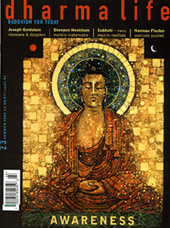Awesome Nightfall
The Life, Time and Poetry of Saigyo
Trans. William Lafleur
Wisdom Publications 2003
$14.95/£8.20 p/b
A man whose mind is
one with the sky-void steps
into a spring mist
and thinks to himself he might
in fact step out of the world
Saigyo lived in 12th-century Japan, but from reading his poetry, it doesn't feel like it. Despite his preoccupations with traditional Japanese, and Buddhist, themes, his waka (five-line traditional verse form) have a modern feel to them. As is globally the case today, 12th-century Japanese society was going through seismic upheavals. It was a period of insecurity and violence. War was being fought to the North, South, East and West. And Saigyo was acutely aware of violence, having been born into a prestigious warrior clan.
Saigyo surprised many when he left the imperial court in 1140, at the age of 23, to become a monk. The confined world of the court was one of greater freedom, especially sexual freedom, than the wider Kyoto society, where homosexual liaisons were taboo. Yet there is some suggestion that Saigyo's shame regarding his homoerotic impulses led to him leaving the court and becoming a monk.
The first half of Awesome Nightfall is an account of his life in the turbulent Japanese culture amid which he was raised. Dotted with his own poems, it provides a good ground from which to read the second half, which consists of about 150 waka. (This was the medium he almost exclusively wrote in.) Perhaps due to his combative upbringing and the complexities of his personal life, his poetry is not full of Buddhist doctrines; it presents the Dharma in a softer, more experiential way, where we are shown, rather than told, essential truths. His poems are alive to the vivid transformations of inner and outer worlds.
An ancient field
and in the sole tree starkly
rising to its side
sits a dove, calling to its mate:
the awesome nightfall.
Not knowing Japanese, I cannot compare Lafleur's translations with the originals. (However the book contains parallel transliterations of the poems, so it is - very satisfyingly - possible to follow their sounds and rhythms.) Despite a few arcane phrases and clunky lines, the poems work well.
Saigyo wasn't quite the Philip Larkin of medieval Japan, but melancholy was no stranger to him. Its evocation through images of solitariness and solitude are exquisite: cultivated in existential aloneness rather than emotionally barren loneliness. He meets this with his eyes as wide open as the full moon he invokes so frequently - the full moon that is his friend, lover, ideal, and mirror to his own solitary heart. Perspective is a word - and an experience - that came to me again and again as I read these waka.
Look at it one way
and high waves seem to engulf
the pines at Futami,
but then ... again ... you see
mist masking the treetops.
Whether or not Saigyo's sexual impulses were sublimated after his tonsure, his relationship with nature certainly has a sensual, even erotic, dimension. The feelings he communicates have not been decided by committee. There is a depth, a complexity, and contradictoriness that is very human.
If my rapt gaze
would not give rise to rumour
and disgrace, I'd
want to spend all spring fixed here,
feasting my eyes on these flowers.
I'll never forget
her look when I said goodbye ...
especially since,
as keepsake, she set her sorrow-
filled face on the moon above.
Throughout his life as a monk Saigyo never lived in a monastery. He disliked the atmosphere of violence and competitiveness in which fighting - and worse - were common. His monastic career began with his living alone in the grounds of a monastery in the capital and over time he moved further and further into the wilderness. Just as Basho was to find Saigyo his main literary inspiration centuries later, so Saigyo was deeply influenced by Kukai, the founder of Shingon, Japanese Tantric Buddhism.
This is an inspiring volume, both poetically and spiritually. Saigyo's solitary life led him to a true independence of heart and mind. And Lafleur communicates well his distilled Dharma-realisations, the special transmissions outside the scriptures that came to Saigyo as he looked into the mirror of the moon and saw his first face - as he stepped out of the world so he could step back into it again.
Clouds thickly mantle
these mountains, but the blocked moon
has already taken up residence
in my mind, so nothing new prevents
me from seeing its serenity there.
Subhadassi



